Accounting Information System Report: Freddy's Model Buses
VerifiedAdded on 2023/06/03
|19
|4066
|279
Report
AI Summary
This report provides a comprehensive analysis of the Accounting Information System (AIS) used by Freddy's Model Buses Shop, addressing the limitations of its current software and proposing improvements. The report focuses on the application of the Resources, Events, and Agents (REA) model to enhance data management and operational efficiency. It examines the shop's revenue cycle, inventory management, and the need for a relational database to support better decision-making. The study highlights the shortcomings of the existing system, such as the inability to generate custom reports easily and the time-consuming manual data review processes. The report recommends integrating the REA model to streamline data analysis and improve the shop's ability to assess key performance indicators, such as revenue and inventory levels. The discussion covers the importance of classifying and recording data accurately, aligning accounting practices with the company's operational needs, and the benefits of an event-based accounting approach. The report also emphasizes the role of accounting software in improving the shop's overall performance by providing better insights into the business operations.
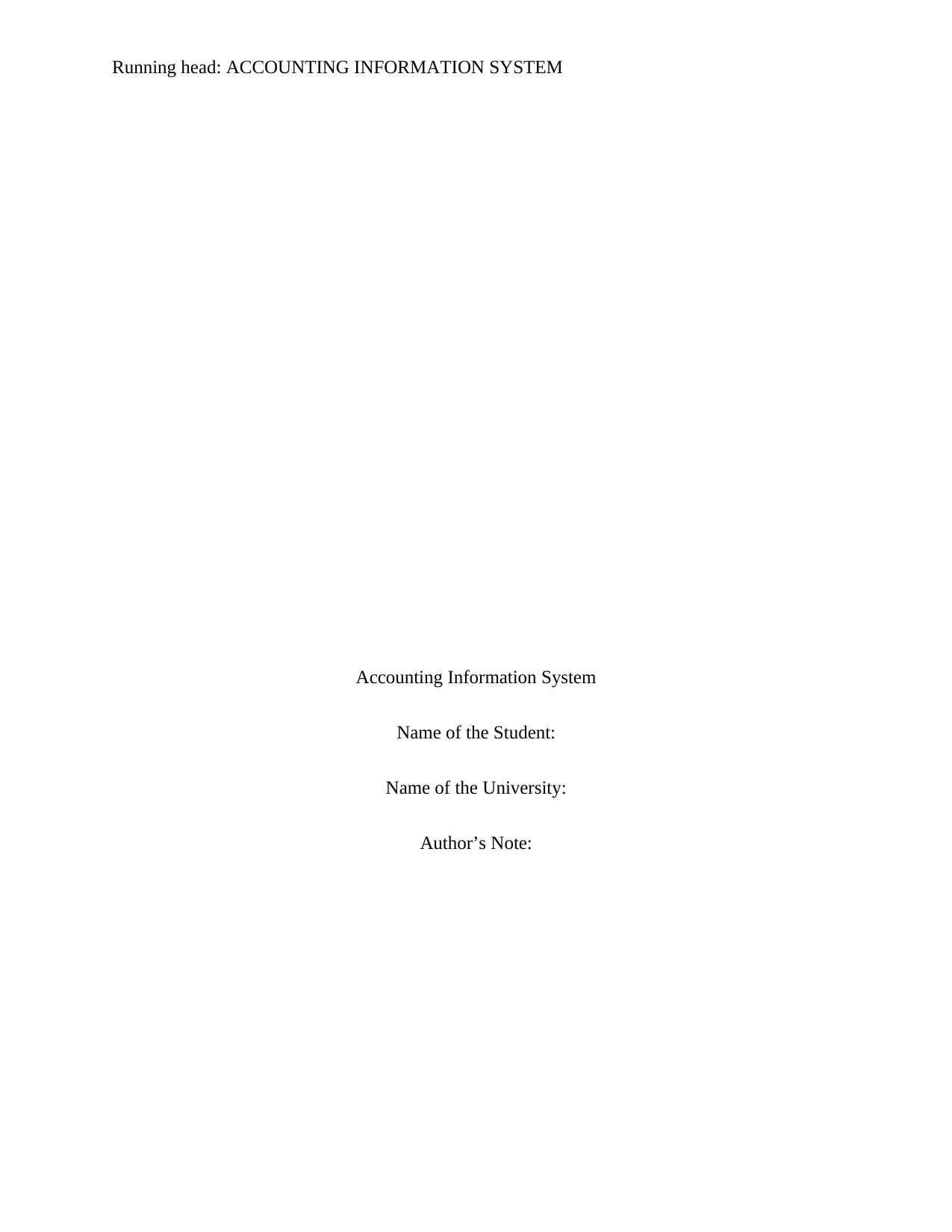
Running head: ACCOUNTING INFORMATION SYSTEM
Accounting Information System
Name of the Student:
Name of the University:
Author’s Note:
Accounting Information System
Name of the Student:
Name of the University:
Author’s Note:
Paraphrase This Document
Need a fresh take? Get an instant paraphrase of this document with our AI Paraphraser
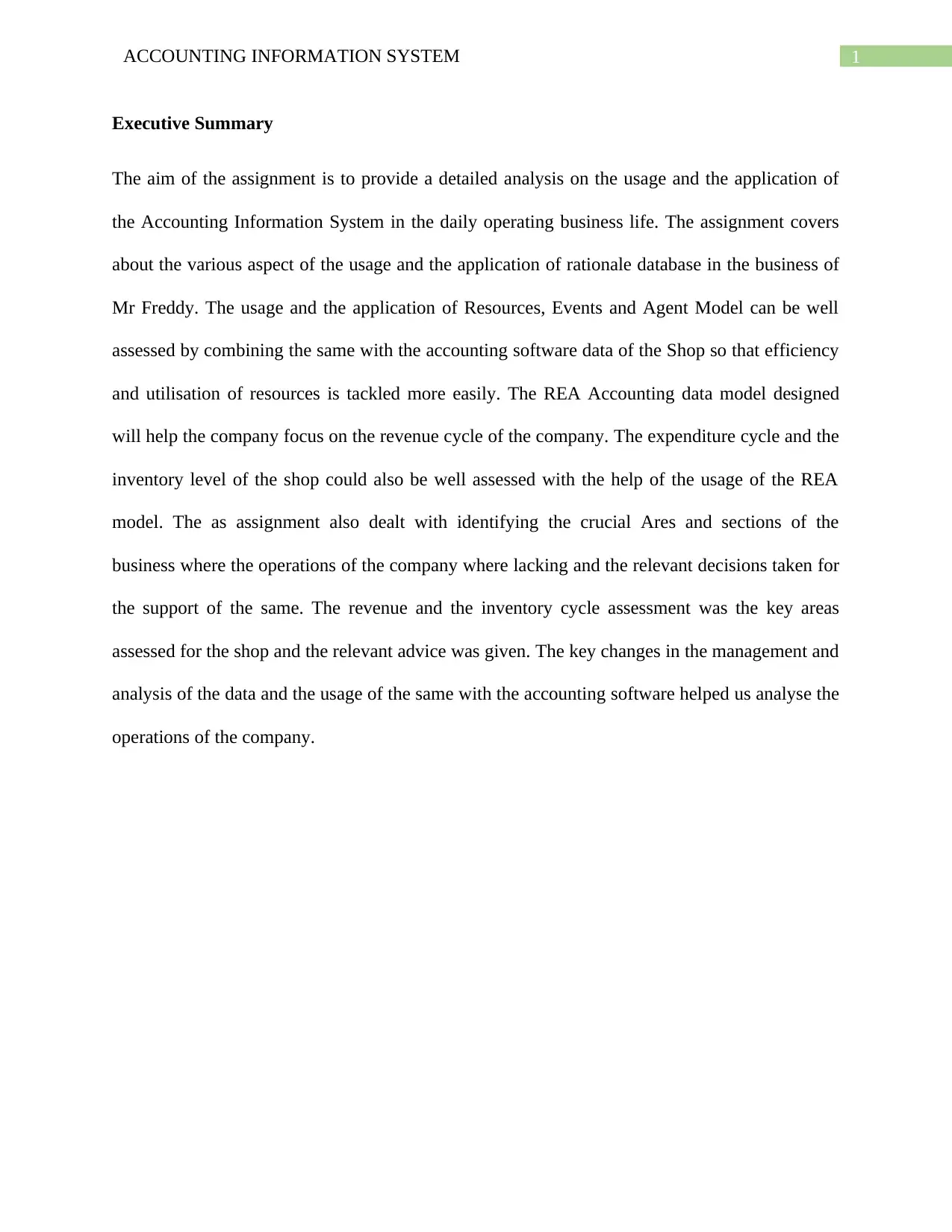
1ACCOUNTING INFORMATION SYSTEM
Executive Summary
The aim of the assignment is to provide a detailed analysis on the usage and the application of
the Accounting Information System in the daily operating business life. The assignment covers
about the various aspect of the usage and the application of rationale database in the business of
Mr Freddy. The usage and the application of Resources, Events and Agent Model can be well
assessed by combining the same with the accounting software data of the Shop so that efficiency
and utilisation of resources is tackled more easily. The REA Accounting data model designed
will help the company focus on the revenue cycle of the company. The expenditure cycle and the
inventory level of the shop could also be well assessed with the help of the usage of the REA
model. The as assignment also dealt with identifying the crucial Ares and sections of the
business where the operations of the company where lacking and the relevant decisions taken for
the support of the same. The revenue and the inventory cycle assessment was the key areas
assessed for the shop and the relevant advice was given. The key changes in the management and
analysis of the data and the usage of the same with the accounting software helped us analyse the
operations of the company.
Executive Summary
The aim of the assignment is to provide a detailed analysis on the usage and the application of
the Accounting Information System in the daily operating business life. The assignment covers
about the various aspect of the usage and the application of rationale database in the business of
Mr Freddy. The usage and the application of Resources, Events and Agent Model can be well
assessed by combining the same with the accounting software data of the Shop so that efficiency
and utilisation of resources is tackled more easily. The REA Accounting data model designed
will help the company focus on the revenue cycle of the company. The expenditure cycle and the
inventory level of the shop could also be well assessed with the help of the usage of the REA
model. The as assignment also dealt with identifying the crucial Ares and sections of the
business where the operations of the company where lacking and the relevant decisions taken for
the support of the same. The revenue and the inventory cycle assessment was the key areas
assessed for the shop and the relevant advice was given. The key changes in the management and
analysis of the data and the usage of the same with the accounting software helped us analyse the
operations of the company.
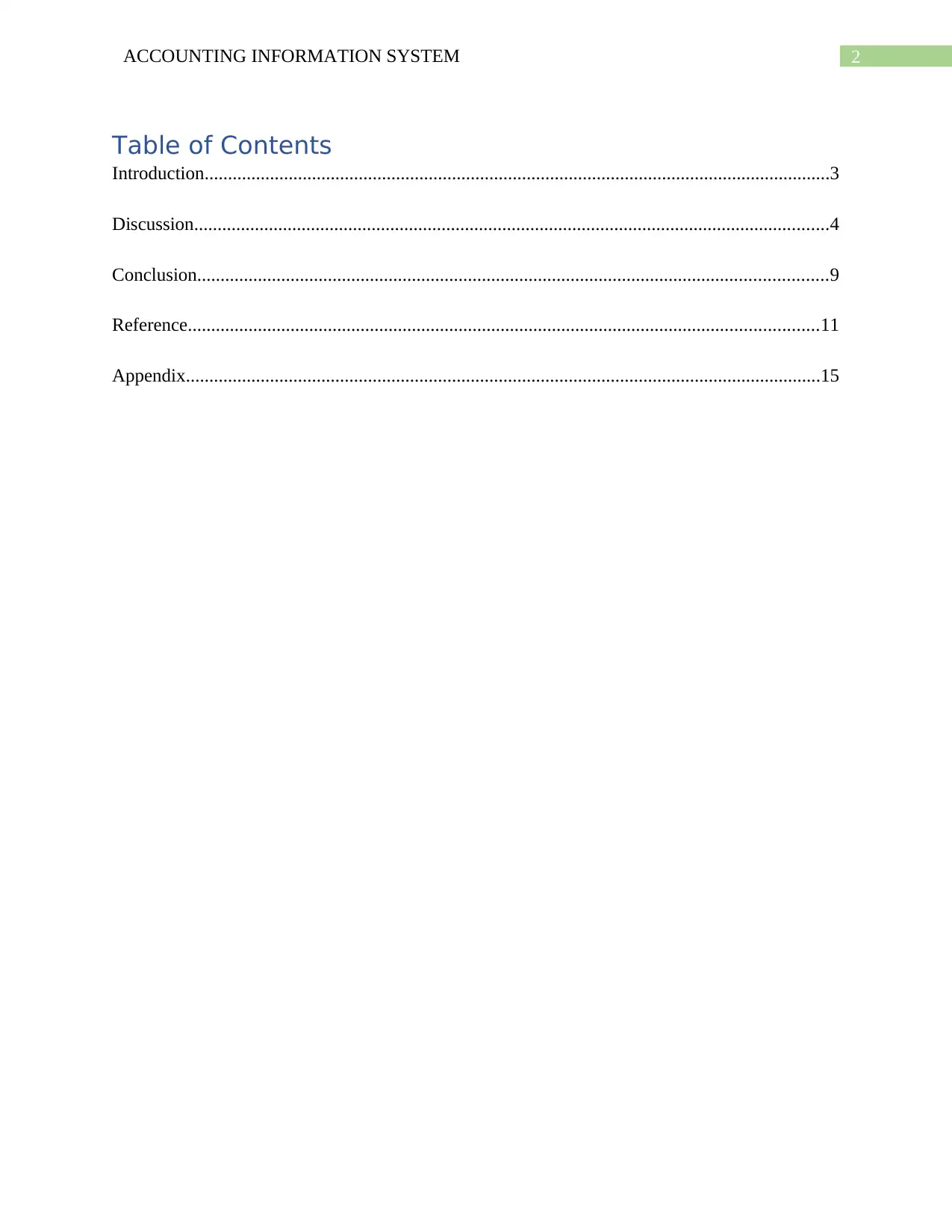
2ACCOUNTING INFORMATION SYSTEM
Table of Contents
Introduction......................................................................................................................................3
Discussion........................................................................................................................................4
Conclusion.......................................................................................................................................9
Reference.......................................................................................................................................11
Appendix........................................................................................................................................15
Table of Contents
Introduction......................................................................................................................................3
Discussion........................................................................................................................................4
Conclusion.......................................................................................................................................9
Reference.......................................................................................................................................11
Appendix........................................................................................................................................15
⊘ This is a preview!⊘
Do you want full access?
Subscribe today to unlock all pages.

Trusted by 1+ million students worldwide
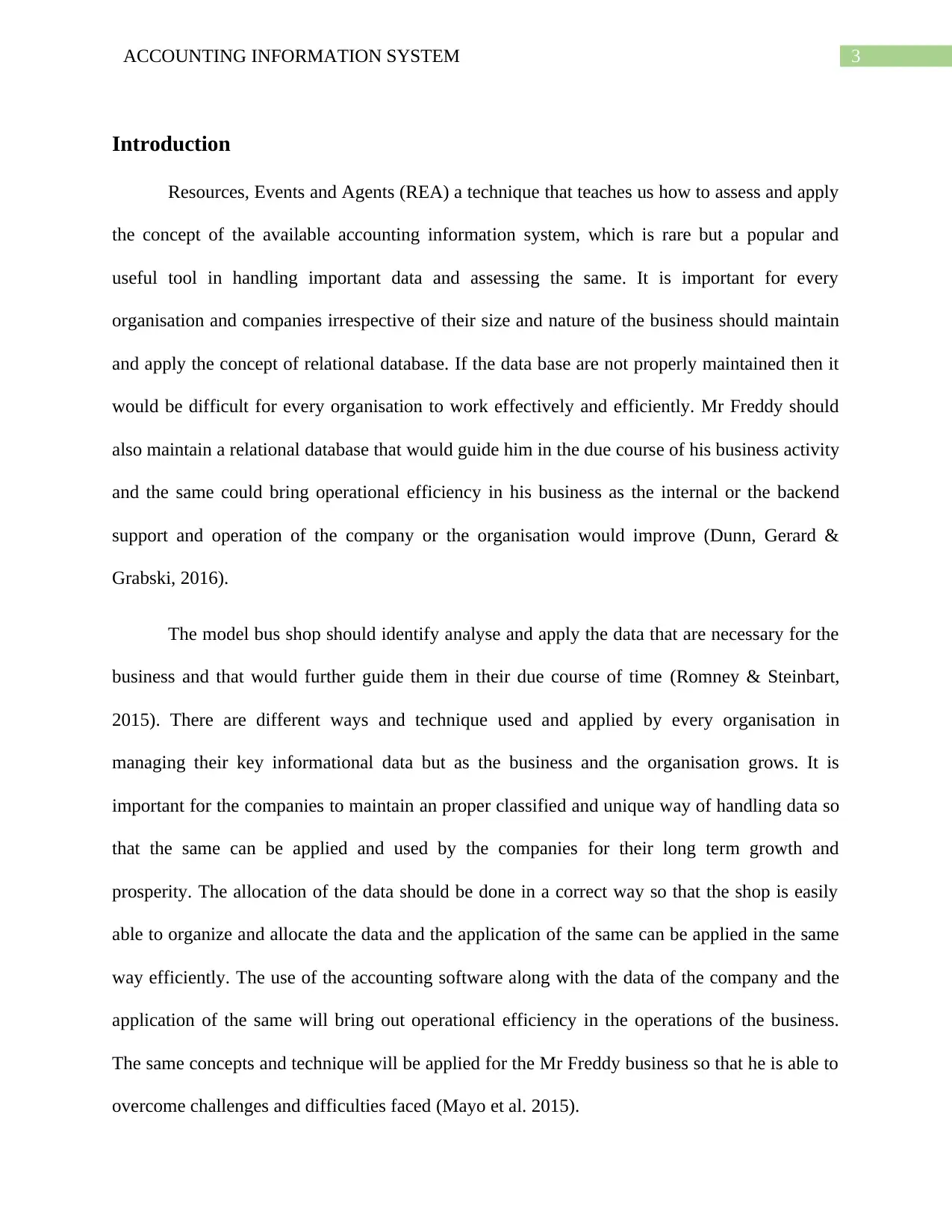
3ACCOUNTING INFORMATION SYSTEM
Introduction
Resources, Events and Agents (REA) a technique that teaches us how to assess and apply
the concept of the available accounting information system, which is rare but a popular and
useful tool in handling important data and assessing the same. It is important for every
organisation and companies irrespective of their size and nature of the business should maintain
and apply the concept of relational database. If the data base are not properly maintained then it
would be difficult for every organisation to work effectively and efficiently. Mr Freddy should
also maintain a relational database that would guide him in the due course of his business activity
and the same could bring operational efficiency in his business as the internal or the backend
support and operation of the company or the organisation would improve (Dunn, Gerard &
Grabski, 2016).
The model bus shop should identify analyse and apply the data that are necessary for the
business and that would further guide them in their due course of time (Romney & Steinbart,
2015). There are different ways and technique used and applied by every organisation in
managing their key informational data but as the business and the organisation grows. It is
important for the companies to maintain an proper classified and unique way of handling data so
that the same can be applied and used by the companies for their long term growth and
prosperity. The allocation of the data should be done in a correct way so that the shop is easily
able to organize and allocate the data and the application of the same can be applied in the same
way efficiently. The use of the accounting software along with the data of the company and the
application of the same will bring out operational efficiency in the operations of the business.
The same concepts and technique will be applied for the Mr Freddy business so that he is able to
overcome challenges and difficulties faced (Mayo et al. 2015).
Introduction
Resources, Events and Agents (REA) a technique that teaches us how to assess and apply
the concept of the available accounting information system, which is rare but a popular and
useful tool in handling important data and assessing the same. It is important for every
organisation and companies irrespective of their size and nature of the business should maintain
and apply the concept of relational database. If the data base are not properly maintained then it
would be difficult for every organisation to work effectively and efficiently. Mr Freddy should
also maintain a relational database that would guide him in the due course of his business activity
and the same could bring operational efficiency in his business as the internal or the backend
support and operation of the company or the organisation would improve (Dunn, Gerard &
Grabski, 2016).
The model bus shop should identify analyse and apply the data that are necessary for the
business and that would further guide them in their due course of time (Romney & Steinbart,
2015). There are different ways and technique used and applied by every organisation in
managing their key informational data but as the business and the organisation grows. It is
important for the companies to maintain an proper classified and unique way of handling data so
that the same can be applied and used by the companies for their long term growth and
prosperity. The allocation of the data should be done in a correct way so that the shop is easily
able to organize and allocate the data and the application of the same can be applied in the same
way efficiently. The use of the accounting software along with the data of the company and the
application of the same will bring out operational efficiency in the operations of the business.
The same concepts and technique will be applied for the Mr Freddy business so that he is able to
overcome challenges and difficulties faced (Mayo et al. 2015).
Paraphrase This Document
Need a fresh take? Get an instant paraphrase of this document with our AI Paraphraser
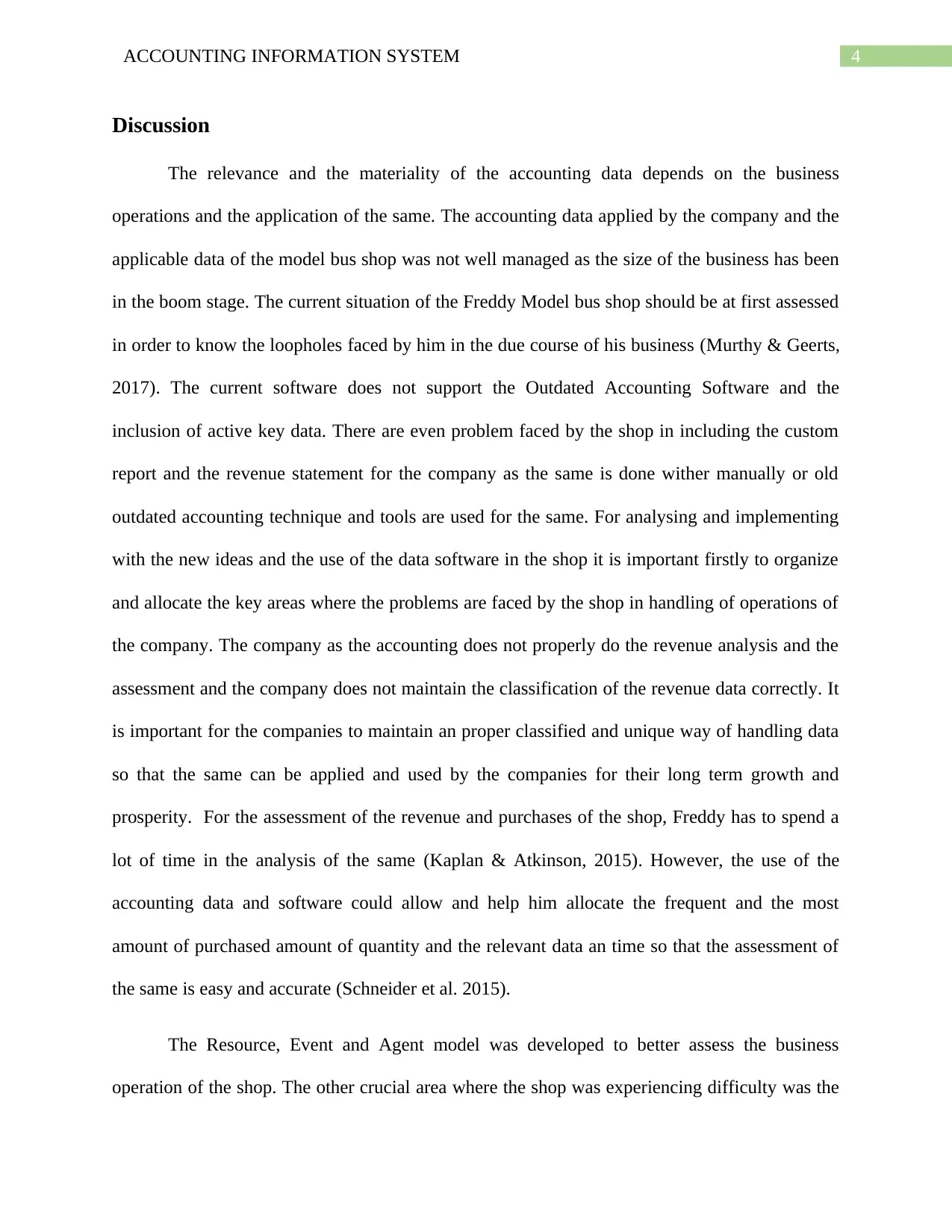
4ACCOUNTING INFORMATION SYSTEM
Discussion
The relevance and the materiality of the accounting data depends on the business
operations and the application of the same. The accounting data applied by the company and the
applicable data of the model bus shop was not well managed as the size of the business has been
in the boom stage. The current situation of the Freddy Model bus shop should be at first assessed
in order to know the loopholes faced by him in the due course of his business (Murthy & Geerts,
2017). The current software does not support the Outdated Accounting Software and the
inclusion of active key data. There are even problem faced by the shop in including the custom
report and the revenue statement for the company as the same is done wither manually or old
outdated accounting technique and tools are used for the same. For analysing and implementing
with the new ideas and the use of the data software in the shop it is important firstly to organize
and allocate the key areas where the problems are faced by the shop in handling of operations of
the company. The company as the accounting does not properly do the revenue analysis and the
assessment and the company does not maintain the classification of the revenue data correctly. It
is important for the companies to maintain an proper classified and unique way of handling data
so that the same can be applied and used by the companies for their long term growth and
prosperity. For the assessment of the revenue and purchases of the shop, Freddy has to spend a
lot of time in the analysis of the same (Kaplan & Atkinson, 2015). However, the use of the
accounting data and software could allow and help him allocate the frequent and the most
amount of purchased amount of quantity and the relevant data an time so that the assessment of
the same is easy and accurate (Schneider et al. 2015).
The Resource, Event and Agent model was developed to better assess the business
operation of the shop. The other crucial area where the shop was experiencing difficulty was the
Discussion
The relevance and the materiality of the accounting data depends on the business
operations and the application of the same. The accounting data applied by the company and the
applicable data of the model bus shop was not well managed as the size of the business has been
in the boom stage. The current situation of the Freddy Model bus shop should be at first assessed
in order to know the loopholes faced by him in the due course of his business (Murthy & Geerts,
2017). The current software does not support the Outdated Accounting Software and the
inclusion of active key data. There are even problem faced by the shop in including the custom
report and the revenue statement for the company as the same is done wither manually or old
outdated accounting technique and tools are used for the same. For analysing and implementing
with the new ideas and the use of the data software in the shop it is important firstly to organize
and allocate the key areas where the problems are faced by the shop in handling of operations of
the company. The company as the accounting does not properly do the revenue analysis and the
assessment and the company does not maintain the classification of the revenue data correctly. It
is important for the companies to maintain an proper classified and unique way of handling data
so that the same can be applied and used by the companies for their long term growth and
prosperity. For the assessment of the revenue and purchases of the shop, Freddy has to spend a
lot of time in the analysis of the same (Kaplan & Atkinson, 2015). However, the use of the
accounting data and software could allow and help him allocate the frequent and the most
amount of purchased amount of quantity and the relevant data an time so that the assessment of
the same is easy and accurate (Schneider et al. 2015).
The Resource, Event and Agent model was developed to better assess the business
operation of the shop. The other crucial area where the shop was experiencing difficulty was the
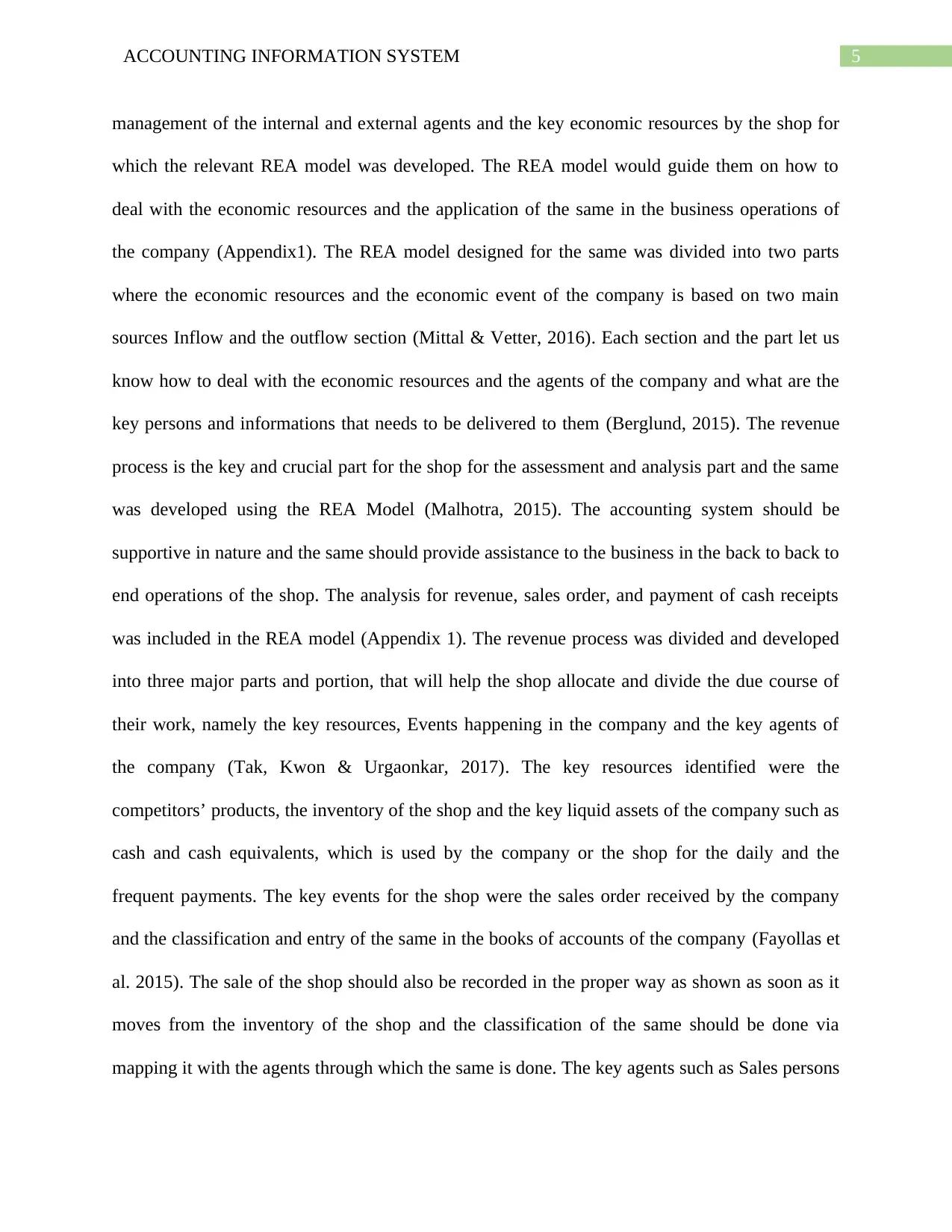
5ACCOUNTING INFORMATION SYSTEM
management of the internal and external agents and the key economic resources by the shop for
which the relevant REA model was developed. The REA model would guide them on how to
deal with the economic resources and the application of the same in the business operations of
the company (Appendix1). The REA model designed for the same was divided into two parts
where the economic resources and the economic event of the company is based on two main
sources Inflow and the outflow section (Mittal & Vetter, 2016). Each section and the part let us
know how to deal with the economic resources and the agents of the company and what are the
key persons and informations that needs to be delivered to them (Berglund, 2015). The revenue
process is the key and crucial part for the shop for the assessment and analysis part and the same
was developed using the REA Model (Malhotra, 2015). The accounting system should be
supportive in nature and the same should provide assistance to the business in the back to back to
end operations of the shop. The analysis for revenue, sales order, and payment of cash receipts
was included in the REA model (Appendix 1). The revenue process was divided and developed
into three major parts and portion, that will help the shop allocate and divide the due course of
their work, namely the key resources, Events happening in the company and the key agents of
the company (Tak, Kwon & Urgaonkar, 2017). The key resources identified were the
competitors’ products, the inventory of the shop and the key liquid assets of the company such as
cash and cash equivalents, which is used by the company or the shop for the daily and the
frequent payments. The key events for the shop were the sales order received by the company
and the classification and entry of the same in the books of accounts of the company (Fayollas et
al. 2015). The sale of the shop should also be recorded in the proper way as shown as soon as it
moves from the inventory of the shop and the classification of the same should be done via
mapping it with the agents through which the same is done. The key agents such as Sales persons
management of the internal and external agents and the key economic resources by the shop for
which the relevant REA model was developed. The REA model would guide them on how to
deal with the economic resources and the application of the same in the business operations of
the company (Appendix1). The REA model designed for the same was divided into two parts
where the economic resources and the economic event of the company is based on two main
sources Inflow and the outflow section (Mittal & Vetter, 2016). Each section and the part let us
know how to deal with the economic resources and the agents of the company and what are the
key persons and informations that needs to be delivered to them (Berglund, 2015). The revenue
process is the key and crucial part for the shop for the assessment and analysis part and the same
was developed using the REA Model (Malhotra, 2015). The accounting system should be
supportive in nature and the same should provide assistance to the business in the back to back to
end operations of the shop. The analysis for revenue, sales order, and payment of cash receipts
was included in the REA model (Appendix 1). The revenue process was divided and developed
into three major parts and portion, that will help the shop allocate and divide the due course of
their work, namely the key resources, Events happening in the company and the key agents of
the company (Tak, Kwon & Urgaonkar, 2017). The key resources identified were the
competitors’ products, the inventory of the shop and the key liquid assets of the company such as
cash and cash equivalents, which is used by the company or the shop for the daily and the
frequent payments. The key events for the shop were the sales order received by the company
and the classification and entry of the same in the books of accounts of the company (Fayollas et
al. 2015). The sale of the shop should also be recorded in the proper way as shown as soon as it
moves from the inventory of the shop and the classification of the same should be done via
mapping it with the agents through which the same is done. The key agents such as Sales persons
⊘ This is a preview!⊘
Do you want full access?
Subscribe today to unlock all pages.

Trusted by 1+ million students worldwide
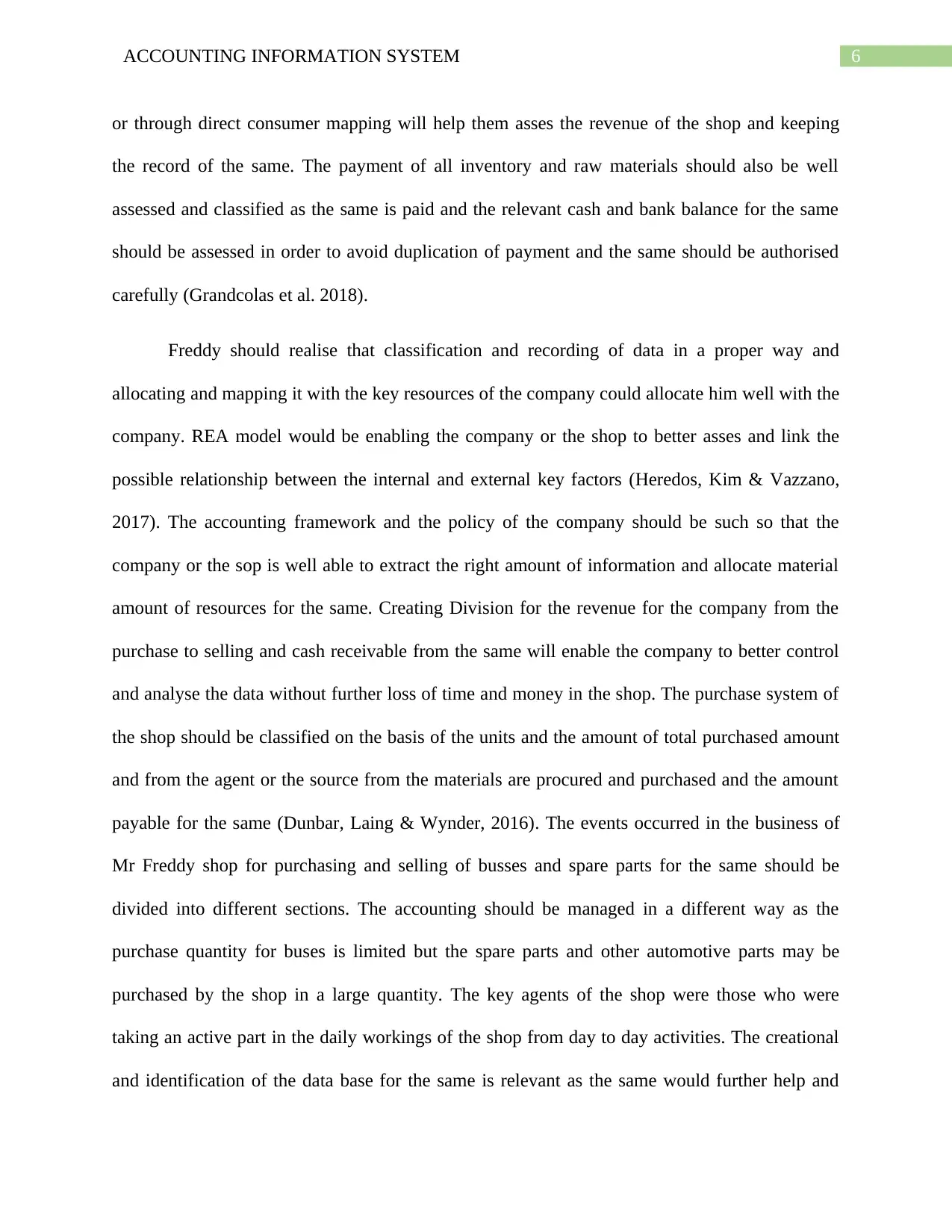
6ACCOUNTING INFORMATION SYSTEM
or through direct consumer mapping will help them asses the revenue of the shop and keeping
the record of the same. The payment of all inventory and raw materials should also be well
assessed and classified as the same is paid and the relevant cash and bank balance for the same
should be assessed in order to avoid duplication of payment and the same should be authorised
carefully (Grandcolas et al. 2018).
Freddy should realise that classification and recording of data in a proper way and
allocating and mapping it with the key resources of the company could allocate him well with the
company. REA model would be enabling the company or the shop to better asses and link the
possible relationship between the internal and external key factors (Heredos, Kim & Vazzano,
2017). The accounting framework and the policy of the company should be such so that the
company or the sop is well able to extract the right amount of information and allocate material
amount of resources for the same. Creating Division for the revenue for the company from the
purchase to selling and cash receivable from the same will enable the company to better control
and analyse the data without further loss of time and money in the shop. The purchase system of
the shop should be classified on the basis of the units and the amount of total purchased amount
and from the agent or the source from the materials are procured and purchased and the amount
payable for the same (Dunbar, Laing & Wynder, 2016). The events occurred in the business of
Mr Freddy shop for purchasing and selling of busses and spare parts for the same should be
divided into different sections. The accounting should be managed in a different way as the
purchase quantity for buses is limited but the spare parts and other automotive parts may be
purchased by the shop in a large quantity. The key agents of the shop were those who were
taking an active part in the daily workings of the shop from day to day activities. The creational
and identification of the data base for the same is relevant as the same would further help and
or through direct consumer mapping will help them asses the revenue of the shop and keeping
the record of the same. The payment of all inventory and raw materials should also be well
assessed and classified as the same is paid and the relevant cash and bank balance for the same
should be assessed in order to avoid duplication of payment and the same should be authorised
carefully (Grandcolas et al. 2018).
Freddy should realise that classification and recording of data in a proper way and
allocating and mapping it with the key resources of the company could allocate him well with the
company. REA model would be enabling the company or the shop to better asses and link the
possible relationship between the internal and external key factors (Heredos, Kim & Vazzano,
2017). The accounting framework and the policy of the company should be such so that the
company or the sop is well able to extract the right amount of information and allocate material
amount of resources for the same. Creating Division for the revenue for the company from the
purchase to selling and cash receivable from the same will enable the company to better control
and analyse the data without further loss of time and money in the shop. The purchase system of
the shop should be classified on the basis of the units and the amount of total purchased amount
and from the agent or the source from the materials are procured and purchased and the amount
payable for the same (Dunbar, Laing & Wynder, 2016). The events occurred in the business of
Mr Freddy shop for purchasing and selling of busses and spare parts for the same should be
divided into different sections. The accounting should be managed in a different way as the
purchase quantity for buses is limited but the spare parts and other automotive parts may be
purchased by the shop in a large quantity. The key agents of the shop were those who were
taking an active part in the daily workings of the shop from day to day activities. The creational
and identification of the data base for the same is relevant as the same would further help and
Paraphrase This Document
Need a fresh take? Get an instant paraphrase of this document with our AI Paraphraser
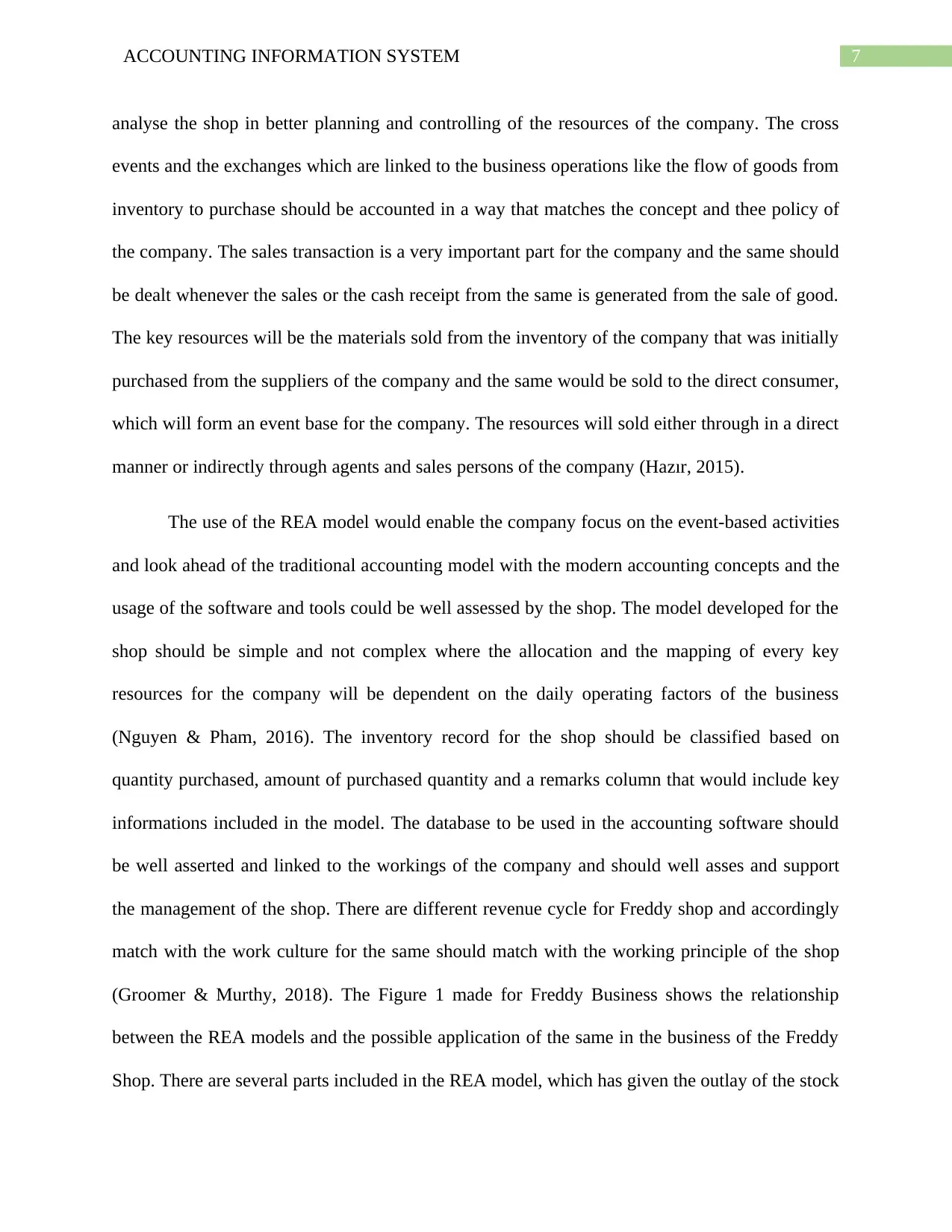
7ACCOUNTING INFORMATION SYSTEM
analyse the shop in better planning and controlling of the resources of the company. The cross
events and the exchanges which are linked to the business operations like the flow of goods from
inventory to purchase should be accounted in a way that matches the concept and thee policy of
the company. The sales transaction is a very important part for the company and the same should
be dealt whenever the sales or the cash receipt from the same is generated from the sale of good.
The key resources will be the materials sold from the inventory of the company that was initially
purchased from the suppliers of the company and the same would be sold to the direct consumer,
which will form an event base for the company. The resources will sold either through in a direct
manner or indirectly through agents and sales persons of the company (Hazır, 2015).
The use of the REA model would enable the company focus on the event-based activities
and look ahead of the traditional accounting model with the modern accounting concepts and the
usage of the software and tools could be well assessed by the shop. The model developed for the
shop should be simple and not complex where the allocation and the mapping of every key
resources for the company will be dependent on the daily operating factors of the business
(Nguyen & Pham, 2016). The inventory record for the shop should be classified based on
quantity purchased, amount of purchased quantity and a remarks column that would include key
informations included in the model. The database to be used in the accounting software should
be well asserted and linked to the workings of the company and should well asses and support
the management of the shop. There are different revenue cycle for Freddy shop and accordingly
match with the work culture for the same should match with the working principle of the shop
(Groomer & Murthy, 2018). The Figure 1 made for Freddy Business shows the relationship
between the REA models and the possible application of the same in the business of the Freddy
Shop. There are several parts included in the REA model, which has given the outlay of the stock
analyse the shop in better planning and controlling of the resources of the company. The cross
events and the exchanges which are linked to the business operations like the flow of goods from
inventory to purchase should be accounted in a way that matches the concept and thee policy of
the company. The sales transaction is a very important part for the company and the same should
be dealt whenever the sales or the cash receipt from the same is generated from the sale of good.
The key resources will be the materials sold from the inventory of the company that was initially
purchased from the suppliers of the company and the same would be sold to the direct consumer,
which will form an event base for the company. The resources will sold either through in a direct
manner or indirectly through agents and sales persons of the company (Hazır, 2015).
The use of the REA model would enable the company focus on the event-based activities
and look ahead of the traditional accounting model with the modern accounting concepts and the
usage of the software and tools could be well assessed by the shop. The model developed for the
shop should be simple and not complex where the allocation and the mapping of every key
resources for the company will be dependent on the daily operating factors of the business
(Nguyen & Pham, 2016). The inventory record for the shop should be classified based on
quantity purchased, amount of purchased quantity and a remarks column that would include key
informations included in the model. The database to be used in the accounting software should
be well asserted and linked to the workings of the company and should well asses and support
the management of the shop. There are different revenue cycle for Freddy shop and accordingly
match with the work culture for the same should match with the working principle of the shop
(Groomer & Murthy, 2018). The Figure 1 made for Freddy Business shows the relationship
between the REA models and the possible application of the same in the business of the Freddy
Shop. There are several parts included in the REA model, which has given the outlay of the stock
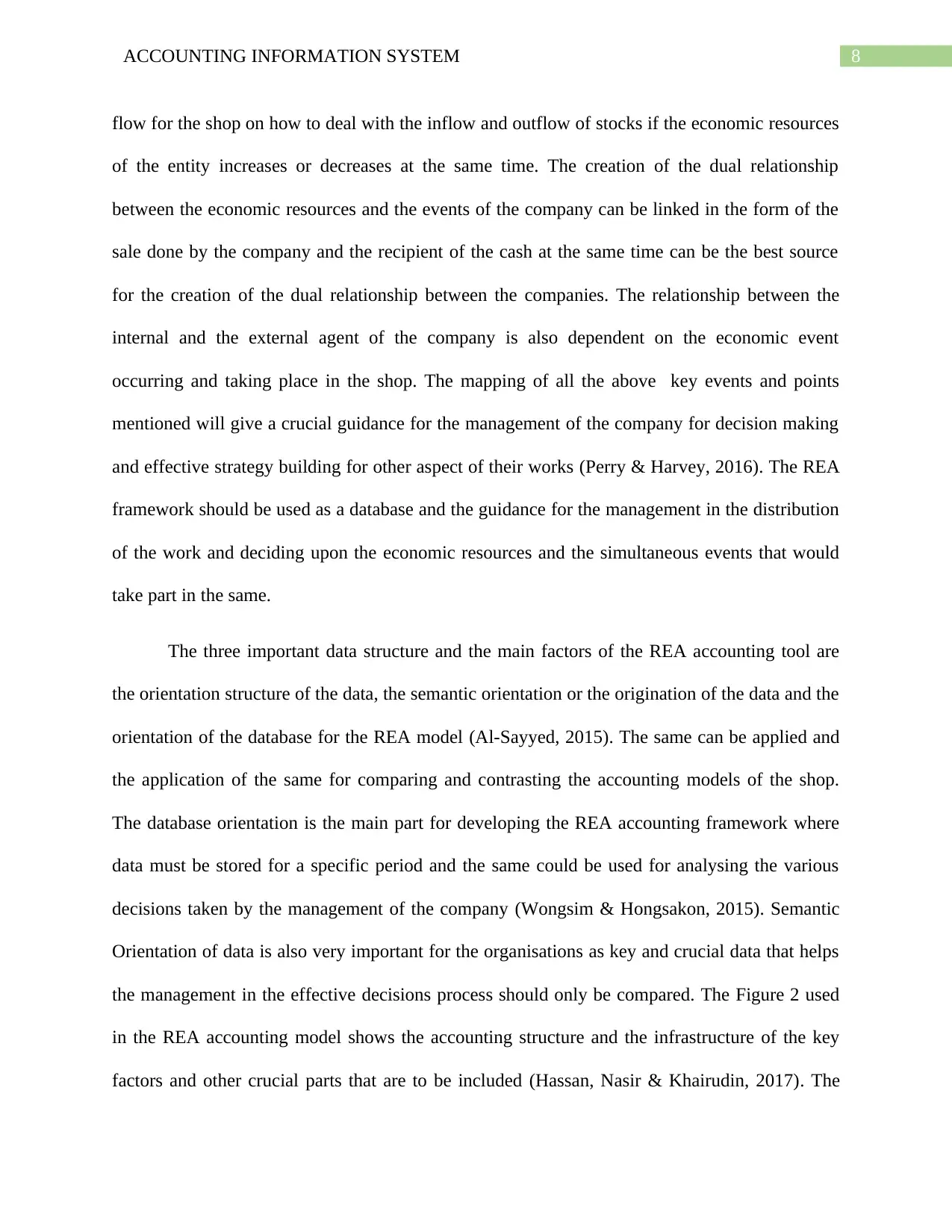
8ACCOUNTING INFORMATION SYSTEM
flow for the shop on how to deal with the inflow and outflow of stocks if the economic resources
of the entity increases or decreases at the same time. The creation of the dual relationship
between the economic resources and the events of the company can be linked in the form of the
sale done by the company and the recipient of the cash at the same time can be the best source
for the creation of the dual relationship between the companies. The relationship between the
internal and the external agent of the company is also dependent on the economic event
occurring and taking place in the shop. The mapping of all the above key events and points
mentioned will give a crucial guidance for the management of the company for decision making
and effective strategy building for other aspect of their works (Perry & Harvey, 2016). The REA
framework should be used as a database and the guidance for the management in the distribution
of the work and deciding upon the economic resources and the simultaneous events that would
take part in the same.
The three important data structure and the main factors of the REA accounting tool are
the orientation structure of the data, the semantic orientation or the origination of the data and the
orientation of the database for the REA model (Al-Sayyed, 2015). The same can be applied and
the application of the same for comparing and contrasting the accounting models of the shop.
The database orientation is the main part for developing the REA accounting framework where
data must be stored for a specific period and the same could be used for analysing the various
decisions taken by the management of the company (Wongsim & Hongsakon, 2015). Semantic
Orientation of data is also very important for the organisations as key and crucial data that helps
the management in the effective decisions process should only be compared. The Figure 2 used
in the REA accounting model shows the accounting structure and the infrastructure of the key
factors and other crucial parts that are to be included (Hassan, Nasir & Khairudin, 2017). The
flow for the shop on how to deal with the inflow and outflow of stocks if the economic resources
of the entity increases or decreases at the same time. The creation of the dual relationship
between the economic resources and the events of the company can be linked in the form of the
sale done by the company and the recipient of the cash at the same time can be the best source
for the creation of the dual relationship between the companies. The relationship between the
internal and the external agent of the company is also dependent on the economic event
occurring and taking place in the shop. The mapping of all the above key events and points
mentioned will give a crucial guidance for the management of the company for decision making
and effective strategy building for other aspect of their works (Perry & Harvey, 2016). The REA
framework should be used as a database and the guidance for the management in the distribution
of the work and deciding upon the economic resources and the simultaneous events that would
take part in the same.
The three important data structure and the main factors of the REA accounting tool are
the orientation structure of the data, the semantic orientation or the origination of the data and the
orientation of the database for the REA model (Al-Sayyed, 2015). The same can be applied and
the application of the same for comparing and contrasting the accounting models of the shop.
The database orientation is the main part for developing the REA accounting framework where
data must be stored for a specific period and the same could be used for analysing the various
decisions taken by the management of the company (Wongsim & Hongsakon, 2015). Semantic
Orientation of data is also very important for the organisations as key and crucial data that helps
the management in the effective decisions process should only be compared. The Figure 2 used
in the REA accounting model shows the accounting structure and the infrastructure of the key
factors and other crucial parts that are to be included (Hassan, Nasir & Khairudin, 2017). The
⊘ This is a preview!⊘
Do you want full access?
Subscribe today to unlock all pages.

Trusted by 1+ million students worldwide
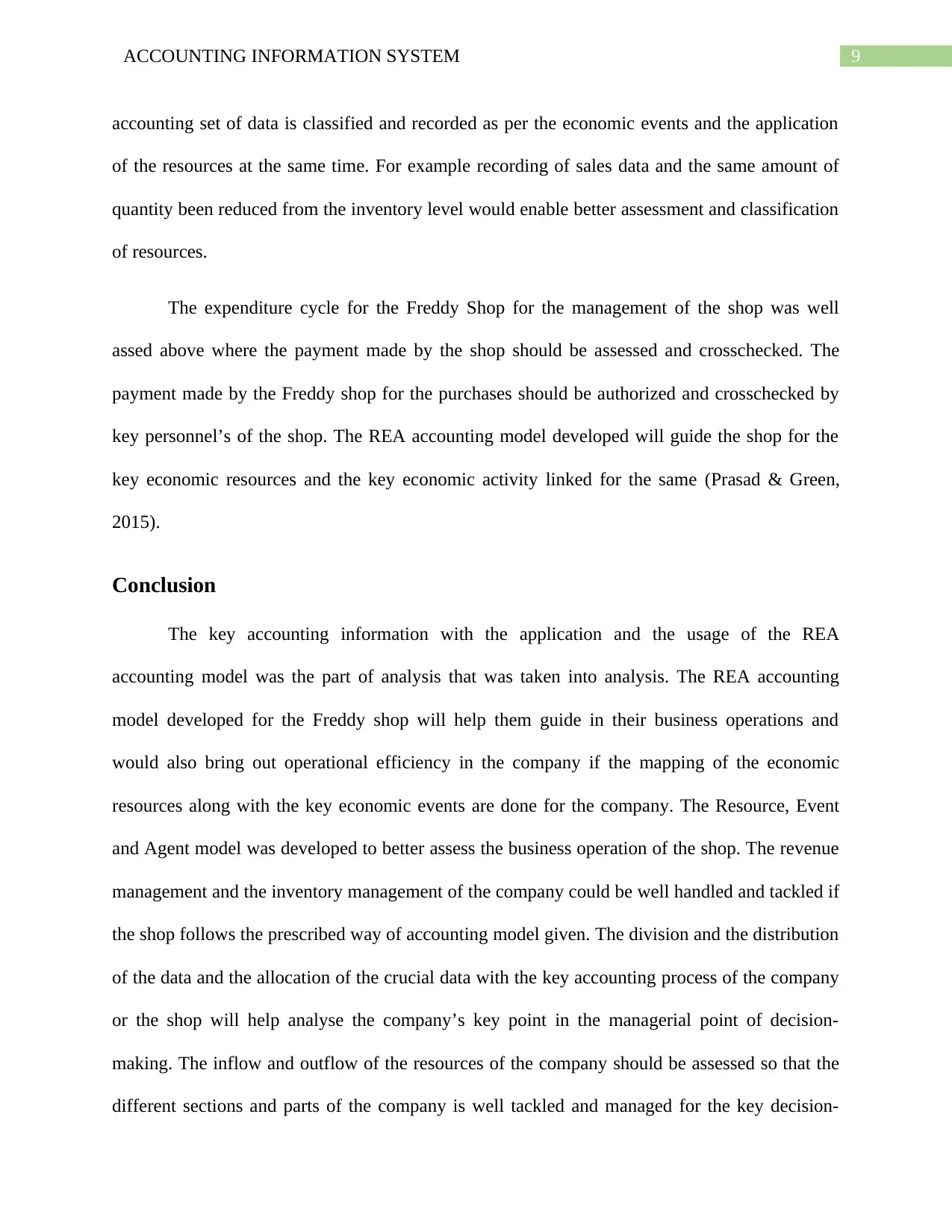
9ACCOUNTING INFORMATION SYSTEM
accounting set of data is classified and recorded as per the economic events and the application
of the resources at the same time. For example recording of sales data and the same amount of
quantity been reduced from the inventory level would enable better assessment and classification
of resources.
The expenditure cycle for the Freddy Shop for the management of the shop was well
assed above where the payment made by the shop should be assessed and crosschecked. The
payment made by the Freddy shop for the purchases should be authorized and crosschecked by
key personnel’s of the shop. The REA accounting model developed will guide the shop for the
key economic resources and the key economic activity linked for the same (Prasad & Green,
2015).
Conclusion
The key accounting information with the application and the usage of the REA
accounting model was the part of analysis that was taken into analysis. The REA accounting
model developed for the Freddy shop will help them guide in their business operations and
would also bring out operational efficiency in the company if the mapping of the economic
resources along with the key economic events are done for the company. The Resource, Event
and Agent model was developed to better assess the business operation of the shop. The revenue
management and the inventory management of the company could be well handled and tackled if
the shop follows the prescribed way of accounting model given. The division and the distribution
of the data and the allocation of the crucial data with the key accounting process of the company
or the shop will help analyse the company’s key point in the managerial point of decision-
making. The inflow and outflow of the resources of the company should be assessed so that the
different sections and parts of the company is well tackled and managed for the key decision-
accounting set of data is classified and recorded as per the economic events and the application
of the resources at the same time. For example recording of sales data and the same amount of
quantity been reduced from the inventory level would enable better assessment and classification
of resources.
The expenditure cycle for the Freddy Shop for the management of the shop was well
assed above where the payment made by the shop should be assessed and crosschecked. The
payment made by the Freddy shop for the purchases should be authorized and crosschecked by
key personnel’s of the shop. The REA accounting model developed will guide the shop for the
key economic resources and the key economic activity linked for the same (Prasad & Green,
2015).
Conclusion
The key accounting information with the application and the usage of the REA
accounting model was the part of analysis that was taken into analysis. The REA accounting
model developed for the Freddy shop will help them guide in their business operations and
would also bring out operational efficiency in the company if the mapping of the economic
resources along with the key economic events are done for the company. The Resource, Event
and Agent model was developed to better assess the business operation of the shop. The revenue
management and the inventory management of the company could be well handled and tackled if
the shop follows the prescribed way of accounting model given. The division and the distribution
of the data and the allocation of the crucial data with the key accounting process of the company
or the shop will help analyse the company’s key point in the managerial point of decision-
making. The inflow and outflow of the resources of the company should be assessed so that the
different sections and parts of the company is well tackled and managed for the key decision-
Paraphrase This Document
Need a fresh take? Get an instant paraphrase of this document with our AI Paraphraser
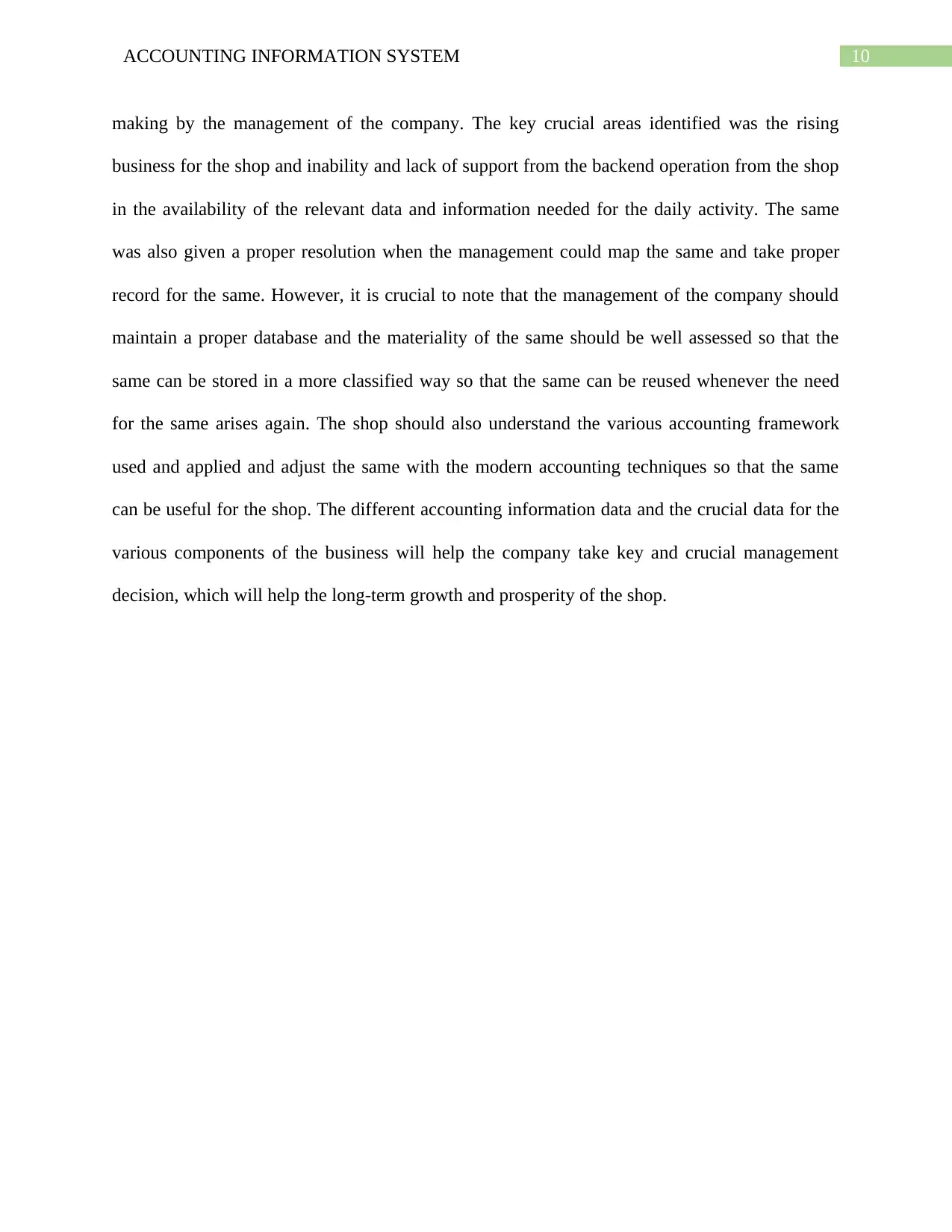
10ACCOUNTING INFORMATION SYSTEM
making by the management of the company. The key crucial areas identified was the rising
business for the shop and inability and lack of support from the backend operation from the shop
in the availability of the relevant data and information needed for the daily activity. The same
was also given a proper resolution when the management could map the same and take proper
record for the same. However, it is crucial to note that the management of the company should
maintain a proper database and the materiality of the same should be well assessed so that the
same can be stored in a more classified way so that the same can be reused whenever the need
for the same arises again. The shop should also understand the various accounting framework
used and applied and adjust the same with the modern accounting techniques so that the same
can be useful for the shop. The different accounting information data and the crucial data for the
various components of the business will help the company take key and crucial management
decision, which will help the long-term growth and prosperity of the shop.
making by the management of the company. The key crucial areas identified was the rising
business for the shop and inability and lack of support from the backend operation from the shop
in the availability of the relevant data and information needed for the daily activity. The same
was also given a proper resolution when the management could map the same and take proper
record for the same. However, it is crucial to note that the management of the company should
maintain a proper database and the materiality of the same should be well assessed so that the
same can be stored in a more classified way so that the same can be reused whenever the need
for the same arises again. The shop should also understand the various accounting framework
used and applied and adjust the same with the modern accounting techniques so that the same
can be useful for the shop. The different accounting information data and the crucial data for the
various components of the business will help the company take key and crucial management
decision, which will help the long-term growth and prosperity of the shop.
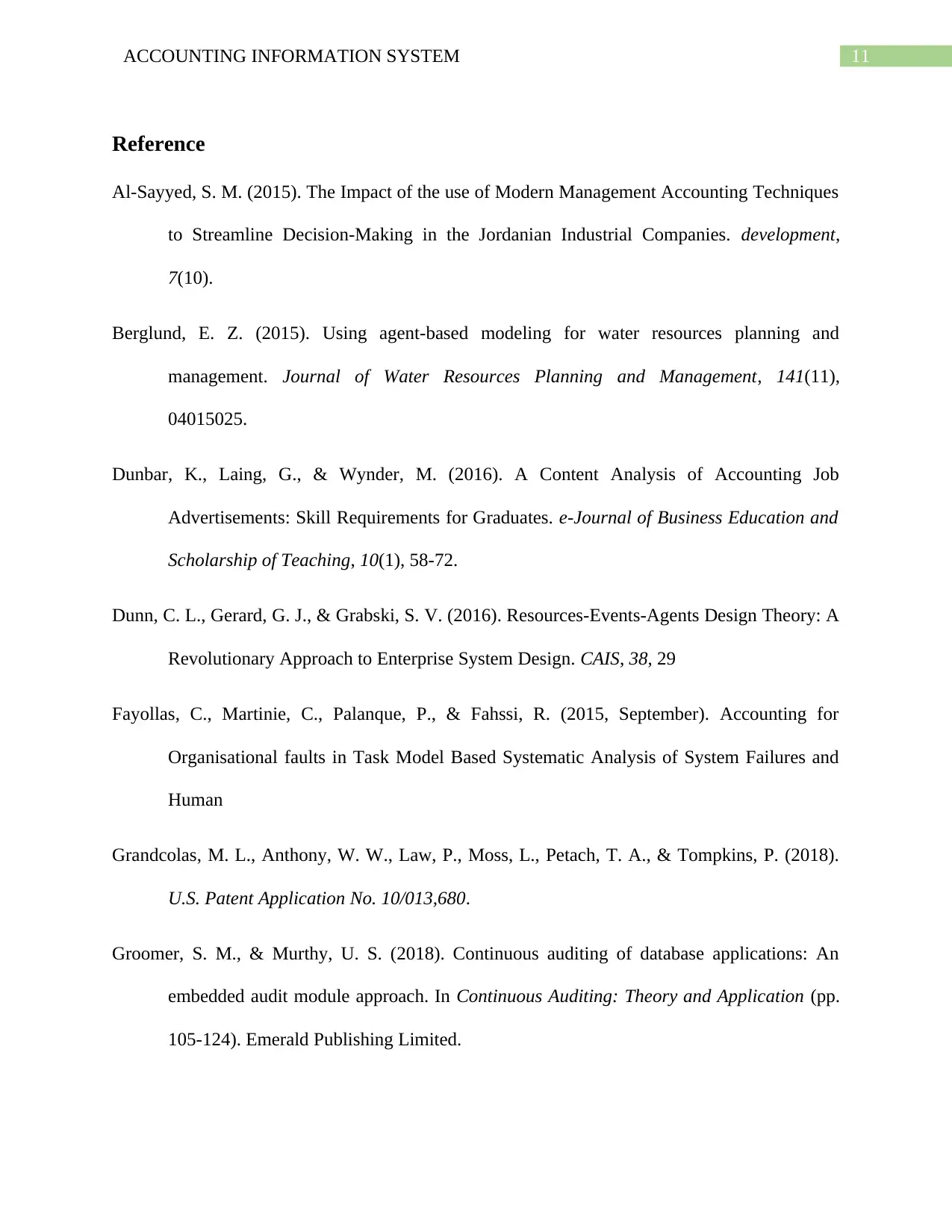
11ACCOUNTING INFORMATION SYSTEM
Reference
Al-Sayyed, S. M. (2015). The Impact of the use of Modern Management Accounting Techniques
to Streamline Decision-Making in the Jordanian Industrial Companies. development,
7(10).
Berglund, E. Z. (2015). Using agent-based modeling for water resources planning and
management. Journal of Water Resources Planning and Management, 141(11),
04015025.
Dunbar, K., Laing, G., & Wynder, M. (2016). A Content Analysis of Accounting Job
Advertisements: Skill Requirements for Graduates. e-Journal of Business Education and
Scholarship of Teaching, 10(1), 58-72.
Dunn, C. L., Gerard, G. J., & Grabski, S. V. (2016). Resources-Events-Agents Design Theory: A
Revolutionary Approach to Enterprise System Design. CAIS, 38, 29
Fayollas, C., Martinie, C., Palanque, P., & Fahssi, R. (2015, September). Accounting for
Organisational faults in Task Model Based Systematic Analysis of System Failures and
Human
Grandcolas, M. L., Anthony, W. W., Law, P., Moss, L., Petach, T. A., & Tompkins, P. (2018).
U.S. Patent Application No. 10/013,680.
Groomer, S. M., & Murthy, U. S. (2018). Continuous auditing of database applications: An
embedded audit module approach. In Continuous Auditing: Theory and Application (pp.
105-124). Emerald Publishing Limited.
Reference
Al-Sayyed, S. M. (2015). The Impact of the use of Modern Management Accounting Techniques
to Streamline Decision-Making in the Jordanian Industrial Companies. development,
7(10).
Berglund, E. Z. (2015). Using agent-based modeling for water resources planning and
management. Journal of Water Resources Planning and Management, 141(11),
04015025.
Dunbar, K., Laing, G., & Wynder, M. (2016). A Content Analysis of Accounting Job
Advertisements: Skill Requirements for Graduates. e-Journal of Business Education and
Scholarship of Teaching, 10(1), 58-72.
Dunn, C. L., Gerard, G. J., & Grabski, S. V. (2016). Resources-Events-Agents Design Theory: A
Revolutionary Approach to Enterprise System Design. CAIS, 38, 29
Fayollas, C., Martinie, C., Palanque, P., & Fahssi, R. (2015, September). Accounting for
Organisational faults in Task Model Based Systematic Analysis of System Failures and
Human
Grandcolas, M. L., Anthony, W. W., Law, P., Moss, L., Petach, T. A., & Tompkins, P. (2018).
U.S. Patent Application No. 10/013,680.
Groomer, S. M., & Murthy, U. S. (2018). Continuous auditing of database applications: An
embedded audit module approach. In Continuous Auditing: Theory and Application (pp.
105-124). Emerald Publishing Limited.
⊘ This is a preview!⊘
Do you want full access?
Subscribe today to unlock all pages.

Trusted by 1+ million students worldwide
1 out of 19
Related Documents
Your All-in-One AI-Powered Toolkit for Academic Success.
+13062052269
info@desklib.com
Available 24*7 on WhatsApp / Email
![[object Object]](/_next/static/media/star-bottom.7253800d.svg)
Unlock your academic potential
Copyright © 2020–2025 A2Z Services. All Rights Reserved. Developed and managed by ZUCOL.





